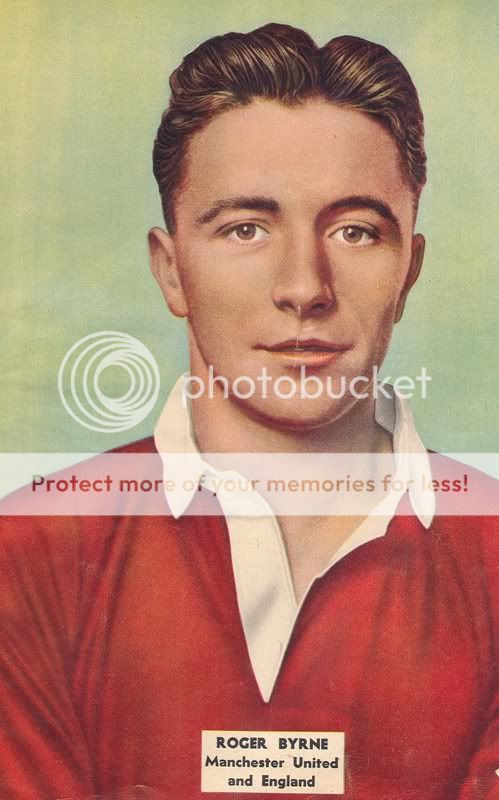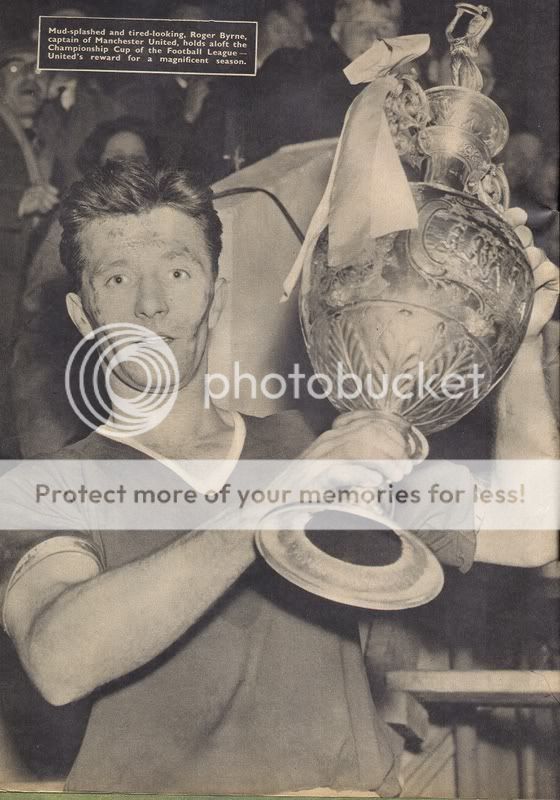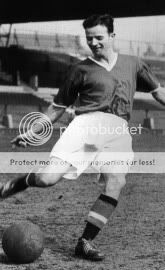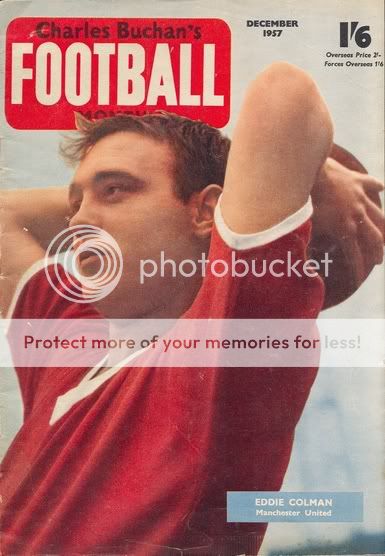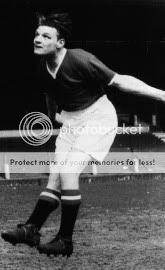mehro
Ass face
50 YEARS ON – “The Smiling Executioner”
His smile would have brightened even the darkest room. With his black curly hair, mischievous eyes, that smile and good looks, Tommy Taylor, standing at 6’1” tall and weighing in at 13 stones, he was the epitome of the professional athlete. Like the “Bestie” of a few years hence, it is true to say that Tommy Taylor would not have looked out of place on a Holywood film set. It is also true to say that the female contingent of Manchester United’s following back in the 1950’s looked upon him as a replica of Adonis!
Tommy Taylor was born on January 29th 1932, in Barnsley, Yorkshire, into a working class mining family. The details of his early life are rather sketchy and buried in the mists of time. From what I remember, Tommy didn’t actually take to playing football seriously until his early teens. He wasn’t a schoolboy international, and I am pretty certain that he didn’t even play for the Barnsley Boys team. Football to the young Tommy Taylor was just a game to be enjoyed with his contemporaries, nothing more, nothing less. He certainly had no aspirations at that early age for a career in the professional game. But as he moved towards his middle teens, he grew and filled out physically. He started playing for a local pub team when he was seventeen years old named “Smithies United.” Tommy started knocking in goals for them and soon came to the attention of the local Barnsley Football League Club. His progress was fairly rapid as he continued to find the back of the net on a regular basis.
He made his debut in the Barnsley first team and the goals continued to flow. Being a local lad, Taylor was blissfully happy playing for his home town team. Everybody knew him, he could live at home, and he was able to stay around his close circle of friends. But as the goals flowed, so his reputation was enhanced, and scouts from the top First Division clubs began to be seen at Oakwell, Barnsley’s home ground in large numbers. It didn’t faze him and he had no intentions of moving on – he was happy.
Manchester United at this time were in a period of rebuilding after their First Division Championship win in season 1951-52. A lot of that team were the wrong side of 30 and United were having trouble finding a goalscoring centre forward. Jack Rowley had moved out to outside left as Roger Byrne had moved to left full-back. Busby had experimented with playing John Aston Senior in the pivotal forward position, but this could only ever be considered a short term project. Eddie lewis filled the spot for a dozen or so games and wasn’t unsuccessful in that he found the net 6 times. However he was still young and raw. In the reserves, United were also experimenting with playing Bill Foulkes at centre forward and he was having quite a time. Bill hit the net regularly, and in one reserve game up at St. James’s Park in Newcastle, he scored four times! Busby was about to give Foulkes his head in the first team but an untimely ankle injury put paid to that plan. So in March 1953, he decided to take the plunge in the transfer market.
In the previous few months, Busby had sent Jimmy Murphy to watch Taylor closely in Barnsley’s matches. Both knew that there was a bevy of First Division clubs watching this exciting, athletic, young centre forward. On Murphy’s last visit to the Oakwell, he informed Busby that there had been more Managers, Chairmen and Scouts from other clubs in attendance, that he thought that there had been a general meeting of the Football League. Busby decided to strike. Both he and Murphy made contact with the Barnsley club, and were allowed to speak to the young Taylor. It was a hard job because Tommy was so settled and did not want to leave his native surroundings – he was settled and happy. One of their biggest problems was trying to convince the boy that he was good enough to play in the First Division. He was such a modest young man. It was the charm of the mercurial Busby that eventually turned the tide as he outlined the future plan that he had for Manchester United. Busby sold him on the prospect of being part of a very young team, and a club full of home grown young players – one of them, Mark Jones, also hailing from the Wombwell area of Barnsley. He convinced him that should he join United, the sky was the limit as to what he could achieve on the football field.
He sold Manchester United to Tommy with not only his charm, but his charisma as well. It’s well documented that he pulled of a coup in beating the other chasing clubs for Taylor’s signature. But the mark of Busby’s managerial qualities also came out in the finalizing of Taylor’s move. Barnsley wouldn’t settle for less than 30,000 pounds, which in 1953, was an astronomical figure. The British transfer record at that time was for inside forward Jackie Sewell who had moved in 1951 from Notts County to Sheffield Wednesday for 35,000 pounds. Busby did not want to burden young Taylor as being a “30,000 pounds player” so taking out his wallet, he pulled from it a 1 pound note and handed it to the lady who had been serving up the teas. The transfer went ahead for the agreed sum of 29,999 pounds and finally, Taylor’s signature was secured.
He moved over to Manchester and was placed into digs with David Pegg in Stretford. It was the beginning of a strong friendship that would only end for them both at the end of a snow bound Munich runway just less than five years ahead. Young David had made his debut for United in the December of 1952 away at Middlesborough and had begun to make the outside left position in the team his own. So it was that on Saturday, March 7th 1953, in front of 52,590 fans at Old Trafford, Tommy Taylor made his debut in the red shirt of United against their Lancashire rivals from Deepdale, Preston North End. It’s interesting to look at the team that lined up that afternoon; Crompton; Aston (Snr), Byrne; Carey, Chilton, Cockburn; Berry, Rowley, Taylor, Pearson, Pegg. Seven members of that team were over 30 years of age! However, it was a great introduction for the young Yorkshireman as he scored twice, his new friend Pegg scored twice, and the “Gunner”, Jack Rowley completed a 5-2 rout for United.
For the United fans of this era, it was the beginning of the club’s ascendancy to the summit of the football ladder. They were exciting times. The addition of Taylor was very instrumental to the team that was beginning to evolve. One by one Busby introduced his youngsters. Wood in goal; Bill Foulkes at right back; first jeff Whitefoot and then Eddie Colman at right half; Mark Jones at centre half; Duncan Edwards at left half; Jackie Blanchflower and then Billy Whelan at inside right; Dennis Viollett at inside left. It took two years from Taylor’s signing before the team really gelled, but once it did, they took British football by storm.
Taylor was a big strong, hard running forward who did not exactly fill the common perception of the barnstorming centre forward. He had great movement and real pace for a big guy, tremendous grace, and he moved wide to both the left and right flanks instead of ploughing the proverbial furrow down the middle of the pitch. He had two great feet and could really hit a ball. In the air, in my opinion he was the greatest header of a ball that I have seen. He had a prodigious leap and seemed to hang the air but still got tremendous force behind the ball. I heard him tell that as a young boy, he used to practice standing jumps. There was a small brick wall alongside a church, close to where he lived in Barnsley and he was eventually able to leap over it from a standing position. His timing was impeccable and to see him hurtling across the goal area to meet either a cross, free kick, or corner kick, was one of football’s joys. He had the ideal temperament – never let foul play get to him, and I saw him take a lot of stick from some of the better known defenders of his time. But he never retaliated, he just got up, got on with the game, and did what he did best – stuck the ball in the back of the opponent’s net. And boy, when he did – did that smile light up the stadiums. George Follows was a journalist who wrote for the Daily Herald, a national morning newspaper of that time. It was George who christened Tommy “the Smiling Executioner” – so apt for the big man. He really was a centre half’s nightmare because he would drag them all over the place and create so much space through the middle for the other forwards to capitalize on. He had the perfect foil in Dennis Viollet, and Dennis profited from so many balls knocked down to his feet by big Tom.
His smile would have brightened even the darkest room. With his black curly hair, mischievous eyes, that smile and good looks, Tommy Taylor, standing at 6’1” tall and weighing in at 13 stones, he was the epitome of the professional athlete. Like the “Bestie” of a few years hence, it is true to say that Tommy Taylor would not have looked out of place on a Holywood film set. It is also true to say that the female contingent of Manchester United’s following back in the 1950’s looked upon him as a replica of Adonis!
Tommy Taylor was born on January 29th 1932, in Barnsley, Yorkshire, into a working class mining family. The details of his early life are rather sketchy and buried in the mists of time. From what I remember, Tommy didn’t actually take to playing football seriously until his early teens. He wasn’t a schoolboy international, and I am pretty certain that he didn’t even play for the Barnsley Boys team. Football to the young Tommy Taylor was just a game to be enjoyed with his contemporaries, nothing more, nothing less. He certainly had no aspirations at that early age for a career in the professional game. But as he moved towards his middle teens, he grew and filled out physically. He started playing for a local pub team when he was seventeen years old named “Smithies United.” Tommy started knocking in goals for them and soon came to the attention of the local Barnsley Football League Club. His progress was fairly rapid as he continued to find the back of the net on a regular basis.
He made his debut in the Barnsley first team and the goals continued to flow. Being a local lad, Taylor was blissfully happy playing for his home town team. Everybody knew him, he could live at home, and he was able to stay around his close circle of friends. But as the goals flowed, so his reputation was enhanced, and scouts from the top First Division clubs began to be seen at Oakwell, Barnsley’s home ground in large numbers. It didn’t faze him and he had no intentions of moving on – he was happy.
Manchester United at this time were in a period of rebuilding after their First Division Championship win in season 1951-52. A lot of that team were the wrong side of 30 and United were having trouble finding a goalscoring centre forward. Jack Rowley had moved out to outside left as Roger Byrne had moved to left full-back. Busby had experimented with playing John Aston Senior in the pivotal forward position, but this could only ever be considered a short term project. Eddie lewis filled the spot for a dozen or so games and wasn’t unsuccessful in that he found the net 6 times. However he was still young and raw. In the reserves, United were also experimenting with playing Bill Foulkes at centre forward and he was having quite a time. Bill hit the net regularly, and in one reserve game up at St. James’s Park in Newcastle, he scored four times! Busby was about to give Foulkes his head in the first team but an untimely ankle injury put paid to that plan. So in March 1953, he decided to take the plunge in the transfer market.
In the previous few months, Busby had sent Jimmy Murphy to watch Taylor closely in Barnsley’s matches. Both knew that there was a bevy of First Division clubs watching this exciting, athletic, young centre forward. On Murphy’s last visit to the Oakwell, he informed Busby that there had been more Managers, Chairmen and Scouts from other clubs in attendance, that he thought that there had been a general meeting of the Football League. Busby decided to strike. Both he and Murphy made contact with the Barnsley club, and were allowed to speak to the young Taylor. It was a hard job because Tommy was so settled and did not want to leave his native surroundings – he was settled and happy. One of their biggest problems was trying to convince the boy that he was good enough to play in the First Division. He was such a modest young man. It was the charm of the mercurial Busby that eventually turned the tide as he outlined the future plan that he had for Manchester United. Busby sold him on the prospect of being part of a very young team, and a club full of home grown young players – one of them, Mark Jones, also hailing from the Wombwell area of Barnsley. He convinced him that should he join United, the sky was the limit as to what he could achieve on the football field.
He sold Manchester United to Tommy with not only his charm, but his charisma as well. It’s well documented that he pulled of a coup in beating the other chasing clubs for Taylor’s signature. But the mark of Busby’s managerial qualities also came out in the finalizing of Taylor’s move. Barnsley wouldn’t settle for less than 30,000 pounds, which in 1953, was an astronomical figure. The British transfer record at that time was for inside forward Jackie Sewell who had moved in 1951 from Notts County to Sheffield Wednesday for 35,000 pounds. Busby did not want to burden young Taylor as being a “30,000 pounds player” so taking out his wallet, he pulled from it a 1 pound note and handed it to the lady who had been serving up the teas. The transfer went ahead for the agreed sum of 29,999 pounds and finally, Taylor’s signature was secured.
He moved over to Manchester and was placed into digs with David Pegg in Stretford. It was the beginning of a strong friendship that would only end for them both at the end of a snow bound Munich runway just less than five years ahead. Young David had made his debut for United in the December of 1952 away at Middlesborough and had begun to make the outside left position in the team his own. So it was that on Saturday, March 7th 1953, in front of 52,590 fans at Old Trafford, Tommy Taylor made his debut in the red shirt of United against their Lancashire rivals from Deepdale, Preston North End. It’s interesting to look at the team that lined up that afternoon; Crompton; Aston (Snr), Byrne; Carey, Chilton, Cockburn; Berry, Rowley, Taylor, Pearson, Pegg. Seven members of that team were over 30 years of age! However, it was a great introduction for the young Yorkshireman as he scored twice, his new friend Pegg scored twice, and the “Gunner”, Jack Rowley completed a 5-2 rout for United.
For the United fans of this era, it was the beginning of the club’s ascendancy to the summit of the football ladder. They were exciting times. The addition of Taylor was very instrumental to the team that was beginning to evolve. One by one Busby introduced his youngsters. Wood in goal; Bill Foulkes at right back; first jeff Whitefoot and then Eddie Colman at right half; Mark Jones at centre half; Duncan Edwards at left half; Jackie Blanchflower and then Billy Whelan at inside right; Dennis Viollett at inside left. It took two years from Taylor’s signing before the team really gelled, but once it did, they took British football by storm.
Taylor was a big strong, hard running forward who did not exactly fill the common perception of the barnstorming centre forward. He had great movement and real pace for a big guy, tremendous grace, and he moved wide to both the left and right flanks instead of ploughing the proverbial furrow down the middle of the pitch. He had two great feet and could really hit a ball. In the air, in my opinion he was the greatest header of a ball that I have seen. He had a prodigious leap and seemed to hang the air but still got tremendous force behind the ball. I heard him tell that as a young boy, he used to practice standing jumps. There was a small brick wall alongside a church, close to where he lived in Barnsley and he was eventually able to leap over it from a standing position. His timing was impeccable and to see him hurtling across the goal area to meet either a cross, free kick, or corner kick, was one of football’s joys. He had the ideal temperament – never let foul play get to him, and I saw him take a lot of stick from some of the better known defenders of his time. But he never retaliated, he just got up, got on with the game, and did what he did best – stuck the ball in the back of the opponent’s net. And boy, when he did – did that smile light up the stadiums. George Follows was a journalist who wrote for the Daily Herald, a national morning newspaper of that time. It was George who christened Tommy “the Smiling Executioner” – so apt for the big man. He really was a centre half’s nightmare because he would drag them all over the place and create so much space through the middle for the other forwards to capitalize on. He had the perfect foil in Dennis Viollet, and Dennis profited from so many balls knocked down to his feet by big Tom.



